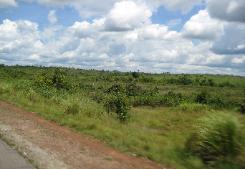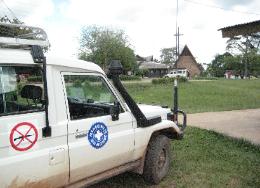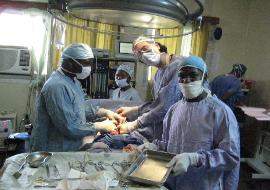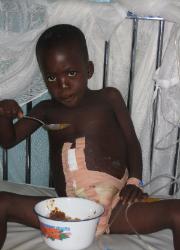Liberia Update
Everyday I drive past Charles Taylor’s farm. There’s not much too see; a few shells of structures
alongside the road and a main house off on a distant hilltop. It’s a stretch of road between the town of
Gbarnga (pronounced bonga’) and Phebe Hospital that seems strangely deserted; everything is quite
and green – I wonder, are people waiting to see what happens at the International Criminal Court in the
Hague? Does the essence of previous happenings linger? Only a relatively few years ago Gbarnga was
the de facto second capital of Liberia, the base of operations for Charles Taylor’s rebels. Today, things
are quiet.
Already a little more than three weeks have passed since my arrival in Liberia, the West African country
founded in the 1840s by freed American slaves. Those original settlers retained close tied to the United
States, naming their capital Monrovia, after the 5th U.S. president, James Monroe, and founding a
republic with a similar constitution, an official language of English, and a flag with 11 red and white
stripes, but only one star. Today, Liberia has stabilized and is recovering from a two decade long civil
war in which an estimated 200,000 people may have died. Things are slowly getting back to normal;
destroyed homes are being rebuilt; children are going to school.
There is a large presence of UN peacekeeping forces here in Liberia: I have seen Nigerians,
Bangladeshis, Nepalese, Indians and Pakistanis – I’m told that UNMIL (the United Nations Mission in
Liberia) is the largest UN peacekeeping operation in the world. I’m not surprised. Every 40 or so
kilometers on the road from Monrovia to Gbarnga we passed manned UN checkpoints and outposts. On
the road, one constantly passes white vehicles with large black “UN” stenciled on the side panels – to
distinguish them from the NGO white vehicles with their logos on the sides.
I’m in Liberia on a six week surgical training mission with Médecins du Monde (MDM), a French NGO with
plenty of white vehicles with their logo on the side. I’ve been on missions with them before in Sudan and
Ethiopia.
MDM has been here in Bong County since 2003, during a time when security was a serious problem.
Now things are much safer, and recently MDM received a US$ 5 million grant to improve the
reproductive health capacity of the local health system. My role is to help improve the emergency
obstetric and emergency surgical skills of local doctors at Phebe Hospital and assist to train rotating
interns in performing caesarian sections.
Phebe Hospital and School of Nursing is a 140-bed facility run by the Lutheran Church and founded in
1964. It was completely destroyed and looted during the war and the staff and patients were forced to
relocate. They have done an excellent job of rebuilding and aside from the lack of running water and x-
rays; it is a rather well stocked and operational facility. Three local doctors do the majority of the
consultations and operating. All are general practitioners but they have developed specialties based on
their own interests. Dr. Williams, the hospital director and county medical officer handles the majority of
pediatric cases, Dr. Sibley – the surgical cases, and Dr. Samson - the obstetrics and gynecology.
Occasionally the Honorable Dr. Gwenigale, the current Liberian Minister of Health who is also a surgeon
and the former medical director of Phebe comes to operate on some of the more complex cases.
Each morning all the doctors and interns meet to discuss the previous evening’s admissions and the
previous day’s events. I’ve been using that time to give a daily presentation on various aspects of
emergency surgery including such topics as: basic trauma care, war wound management, trauma in
pregnancy, damage control surgery and burn management. I have also been involved in bedside
teaching on both the OB and Med/Surg wards.
In the operating theatre, the caseload has been the usual mix (usual for a place like this – not so usual
for a surgeon in the US): typhoid perforations, incarcerated hernias, midgut volvulus, a destructive
delivery of a dead fetus and multiple trauma cases including a shotgun injury to the arm, a uretheral
injury from a fall, a small bowel injury in a pedestrian hit by a motorcycle, a splenic laceration, a
hemothorax, and even a few elective hernias; and now that the Danish OB/GYN who was here helping
for 6 week has gone, plenty of c-sections.
So far, the most gratifying case was of a six-year-old boy who presented late one night with a six-day
history of an incarcerated inguinal hernia. He was profoundly dehydrated and we were concerned that
he would not survive an operation or even the night. We admitted him, started him on antibiotics and IV
fluid. Much to my delight, he had improved by the next morning and I was able to operate and resect his
gangrenous small intestine. He is currently doing, as they say in Liberian English, plenty fine on the
ward eating such local delicacies as potato greens and fufu.
For those who are interested in the accommodations and food, don’t worry, I’m not suffering too much.
The guesthouse has enough rooms so that all the expats (currently 4 in Gbarnga) have our own room.
There’s a cook who is actually pretty accomplished and for local fare, the hospital cafeteria isn’t so bad,
specializing in local dishes such as fufu (a glutinous mash made from cassava) and potato greens
(similar to spinach), chicken, beef, rice and they even have diet coke. The rainy season has yet to start
in earnest and the temperature has been surprisingly moderate. Our main generator malfunctioned so
we are now using much smaller and louder individual units in the office and guesthouse, but we are
surviving. I’ve even grown accustomed to the sharp resounding crashes of ripe mangos plummeting
onto the zinc roof in the middle of the night.
So, each morning on my way to the hospital, I try not to think about the man on trial for crimes against
humanity, the former Liberian president whose campaign slogan was “He killed my Ma, he killed my Pa,
but I will vote for him.” I concentrate instead on the cheerful throngs of children scurrying to school; each
with their vibrantly colored uniform: indigo trimmed with white, shirt and trouser or skirt combinations of
rose and fuchsia, ivory and taupe, jade and goldenrod, tangerine and ebony or powder and royal blue. I
watch from the car; some of the children stare back, some point, some cry wha’t man, wha’t man.
Best to all,
Adam
Everyday I drive past Charles Taylor’s farm. There’s not much too see; a few shells of structures
alongside the road and a main house off on a distant hilltop. It’s a stretch of road between the town of
Gbarnga (pronounced bonga’) and Phebe Hospital that seems strangely deserted; everything is quite
and green – I wonder, are people waiting to see what happens at the International Criminal Court in the
Hague? Does the essence of previous happenings linger? Only a relatively few years ago Gbarnga was
the de facto second capital of Liberia, the base of operations for Charles Taylor’s rebels. Today, things
are quiet.
Already a little more than three weeks have passed since my arrival in Liberia, the West African country
founded in the 1840s by freed American slaves. Those original settlers retained close tied to the United
States, naming their capital Monrovia, after the 5th U.S. president, James Monroe, and founding a
republic with a similar constitution, an official language of English, and a flag with 11 red and white
stripes, but only one star. Today, Liberia has stabilized and is recovering from a two decade long civil
war in which an estimated 200,000 people may have died. Things are slowly getting back to normal;
destroyed homes are being rebuilt; children are going to school.
There is a large presence of UN peacekeeping forces here in Liberia: I have seen Nigerians,
Bangladeshis, Nepalese, Indians and Pakistanis – I’m told that UNMIL (the United Nations Mission in
Liberia) is the largest UN peacekeeping operation in the world. I’m not surprised. Every 40 or so
kilometers on the road from Monrovia to Gbarnga we passed manned UN checkpoints and outposts. On
the road, one constantly passes white vehicles with large black “UN” stenciled on the side panels – to
distinguish them from the NGO white vehicles with their logos on the sides.
I’m in Liberia on a six week surgical training mission with Médecins du Monde (MDM), a French NGO with
plenty of white vehicles with their logo on the side. I’ve been on missions with them before in Sudan and
Ethiopia.
MDM has been here in Bong County since 2003, during a time when security was a serious problem.
Now things are much safer, and recently MDM received a US$ 5 million grant to improve the
reproductive health capacity of the local health system. My role is to help improve the emergency
obstetric and emergency surgical skills of local doctors at Phebe Hospital and assist to train rotating
interns in performing caesarian sections.
Phebe Hospital and School of Nursing is a 140-bed facility run by the Lutheran Church and founded in
1964. It was completely destroyed and looted during the war and the staff and patients were forced to
relocate. They have done an excellent job of rebuilding and aside from the lack of running water and x-
rays; it is a rather well stocked and operational facility. Three local doctors do the majority of the
consultations and operating. All are general practitioners but they have developed specialties based on
their own interests. Dr. Williams, the hospital director and county medical officer handles the majority of
pediatric cases, Dr. Sibley – the surgical cases, and Dr. Samson - the obstetrics and gynecology.
Occasionally the Honorable Dr. Gwenigale, the current Liberian Minister of Health who is also a surgeon
and the former medical director of Phebe comes to operate on some of the more complex cases.
Each morning all the doctors and interns meet to discuss the previous evening’s admissions and the
previous day’s events. I’ve been using that time to give a daily presentation on various aspects of
emergency surgery including such topics as: basic trauma care, war wound management, trauma in
pregnancy, damage control surgery and burn management. I have also been involved in bedside
teaching on both the OB and Med/Surg wards.
In the operating theatre, the caseload has been the usual mix (usual for a place like this – not so usual
for a surgeon in the US): typhoid perforations, incarcerated hernias, midgut volvulus, a destructive
delivery of a dead fetus and multiple trauma cases including a shotgun injury to the arm, a uretheral
injury from a fall, a small bowel injury in a pedestrian hit by a motorcycle, a splenic laceration, a
hemothorax, and even a few elective hernias; and now that the Danish OB/GYN who was here helping
for 6 week has gone, plenty of c-sections.
So far, the most gratifying case was of a six-year-old boy who presented late one night with a six-day
history of an incarcerated inguinal hernia. He was profoundly dehydrated and we were concerned that
he would not survive an operation or even the night. We admitted him, started him on antibiotics and IV
fluid. Much to my delight, he had improved by the next morning and I was able to operate and resect his
gangrenous small intestine. He is currently doing, as they say in Liberian English, plenty fine on the
ward eating such local delicacies as potato greens and fufu.
For those who are interested in the accommodations and food, don’t worry, I’m not suffering too much.
The guesthouse has enough rooms so that all the expats (currently 4 in Gbarnga) have our own room.
There’s a cook who is actually pretty accomplished and for local fare, the hospital cafeteria isn’t so bad,
specializing in local dishes such as fufu (a glutinous mash made from cassava) and potato greens
(similar to spinach), chicken, beef, rice and they even have diet coke. The rainy season has yet to start
in earnest and the temperature has been surprisingly moderate. Our main generator malfunctioned so
we are now using much smaller and louder individual units in the office and guesthouse, but we are
surviving. I’ve even grown accustomed to the sharp resounding crashes of ripe mangos plummeting
onto the zinc roof in the middle of the night.
So, each morning on my way to the hospital, I try not to think about the man on trial for crimes against
humanity, the former Liberian president whose campaign slogan was “He killed my Ma, he killed my Pa,
but I will vote for him.” I concentrate instead on the cheerful throngs of children scurrying to school; each
with their vibrantly colored uniform: indigo trimmed with white, shirt and trouser or skirt combinations of
rose and fuchsia, ivory and taupe, jade and goldenrod, tangerine and ebony or powder and royal blue. I
watch from the car; some of the children stare back, some point, some cry wha’t man, wha’t man.
Best to all,
Adam



